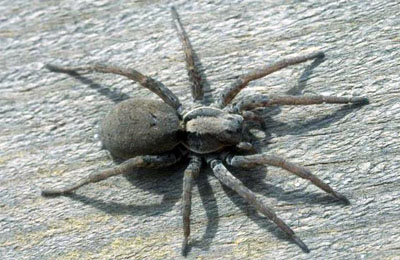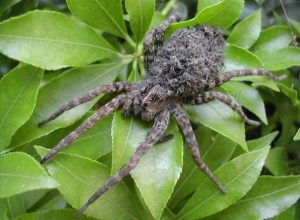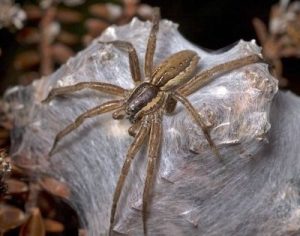Yikes! Big Hairy Spiders
By Ann M. Mason, Fairfax Master Gardener

Wolf Spider
As the weather starts to chill, outdoor life seeks a warmer home — sometimes in our houses. Among the variety of large eight-legged, hairy ‘critters’ that might alarm residents are two solitary and shy, albeit BIG, spiders. The first genera include members of the family Lycosidae called wolf spiders. In Greek, Lucos means wolf. The second group, nursery web spiders and fishing spiders, are from the genus Dolomedes and are members of the family Pisauridae. While most fishing and nursery web spiders live near water, Dolomedes tenebrosus lives in wooded areas as a tree dwelling spider.
If residents of Northern Virginia see large hairy spiders in their homes, it is likely to be either one of the three genera of wolf spiders common in Virginia: Hogna, Rabidosa and Tigrosa or the nursery web spider, Dolomedes.
Spiders have two body sections: the cephalothorax, which is the head fused to the thorax, and the abdomen. Attached to the cephalothorax are six or eight eyes, two segmented pedipalps and eight segmented legs. While the spider’s pedipalps look like legs, they are not. Scientists consider the pedipalps more like an antennae assisting the spider to sense objects, grab prey and in males, transfer sperm to the female. The second body segment is the abdomen, which contains the digestive and reproductive systems and other important organs. The spinnerets, which produce silk, lie at the end of the abdomen.
Neither wolf spiders nor nursery web spiders spin webs to catch prey. Both spiders are solitary hunters and only meet up with another spider to mate (or to eat them). The females are larger than the males, and the females live longer, up to two years.
Wolf Spiders
Wolf spiders hunt often at night. Some species actively roam to find insect prey; others lie patiently waiting in tunnels for prey to pass by. Smaller insects are on their usual menu, but larger females may eat crickets, grasshoppers, or small lizards. The body size of the female wolf spider ranges between 1/4 inch (0.5 cm) to 1 1/3 inches (3.5 cm). With legs up to 1.5 inches (4 cm), the wolf spider can stretch to 3 to 4 inches (8 to 10 cm)!
A typical hunting behavior for the wolf spider is to pounce on prey, quickly grab prey with their pedipalps, roll onto their back to hold prey in a basket position and then bite their prey. Wolf spiders benefit gardeners by reducing insect pests, particularly in agricultural areas, meadows, and grasslands.

Eye Arrangement of a Hogna wolf spider
By appearance, gardeners can recognize wolf spiders from the three rows for their eight eyes: four small eyes on the bottom row, two larger eyes in the middle row and two medium-sized eyes off to the side and back of the cephalothorax. This eye arrangement leads to better vision than other spiders.
Brown, beige, gray or black coloration of wolf spiders helps them to blend into their environment since they are tasty morsels for birds, wasps and geckos. Some species have patterns of stripes or blotches, which help to camouflage them. Their hairy legs are usually brown but occasionally have alternating bands of color.

Female wolf spider carrying hatchlings
Solitary in nature, the larger females and smaller male wolf spiders only come together to mate. After mating, the female lays dozens of eggs and wraps them in silk to create an egg sac that she carries attached to her spinneret at the end of the abdomen. One might think that this arrangement interferes with hunting. Not at all. The female arches her abdomen to carry the egg sac. Once the eggs hatch, the hatchlings scramble up the abdomen where the young spiders hitchhike a ride for a couple of weeks until they are ready to set out on their own. The hatchlings appear like the adult wolf spider but will need to molt several times to shed their exoskeletons and grow larger. Male wolf spiders live about one year; females can live two years or longer.
Nursery Web Spider
The nursery web spider is slightly smaller than the wolf spider. The body of the female ranges from 1/2 inch (1.5 cm) to 1 inch (2.5 cm) and with legs that stretch about 1 inch (2.5 cm) to each side of the body. The nursery web spider can reach 2.5 to 3 inches (6.5 to 8 cm). The nursery web spider’s eight eyes are arranged in two rows of four. The color of the hairy legs of the nursery web spider often appears as alternating bands of black and brown and sometimes red, brown and black. Some scientists report that there is a dark W-shaped marking on the upper abdominal surface.
The nursery web spider is a solitary hunter often found near water and moist woods. It can walk on water to catch tadpoles and insects. It can also dive under the water for prey or to avoid predators, which is why they are called fishing spiders.

Female nursery web spider guarding her nursery
Female nursery spiders are known to eat the male after mating. Scientists suggest that the female finds this easy nutrition for the pregnancy. Scientists have observed that some females eat the male before mating and speculate the reason might be the male did not ‘suit’ the female. The female nursery web spider lays eggs in a sac she carries around in her jaws. When the eggs are close to hatching, she creates a nursery of folded leaves spun together in a web. She hovers close by until her eggs hatch, for a week or so, until the hatchlings can survive on their own.
While the wolf spider and nursery web spider look similar, there are distinguishing characteristics:

Eye arrangement for the wolf and nursery web spiders
- The eye arrangements differ. The wolf spider has three rows of eyes, and the eye size in each row differs. The middle row of eyes is significantly larger than the lower or top set. In contrast, the nursery web spider has two rows of four similarly-sized eyes.
- While each of the female spiders carries their own egg sacs, once hatched their behavior differs. The wolf spider carries her egg sac attached to the spinneret on her abdomen and then carries her hatchlings on her back. The nursery web spider carries the egg sac with her jaws and closer to egg hatching, she webs a nest in leaves. She hovers close by waiting for the eggs to hatch and the hatchlings to grow to independence.
Seeing either of these big spiders in the house might alarm homeowners. Both spiders are accidental wanderers into the home. Neither is dangerous to humans. The wary homeowner can scoop up the wayward spider by sliding a piece of paper under it, putting a cup on top and then releasing the captured spider back outdoors (where they would prefer to live). Outdoors, the spiders can resume the hunt for the insects that plague your garden.
Resources
• Lycosidae, Biokids Critter Catalog, University of Michigan
• Wolf Spiders, Missouri Department of Conservation
• Wolf Spiders and Fishing Spiders, Eric Day, Virginia Cooperative Extension, Virginia Tech
Publication 3104-1586
• Spiders in Virginia, Spider ID
• Pisauridae — Nursery Web Spiders, Steve Jacobs, Penn State Extension
• Fishing Spiders and Wolf Spiders, James Baker, NC State Extension
• Dark Fishing Spider, Missouri Department of Conservation
• Wolf Spiders, Spider Eye Arrangements, BugGuide, Iowa State University, Department of Entomology
• Spider Identification Guide, Gerald S. Wegner, IPM Institute of North America